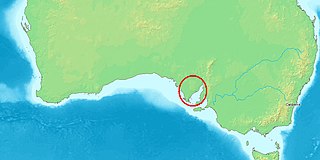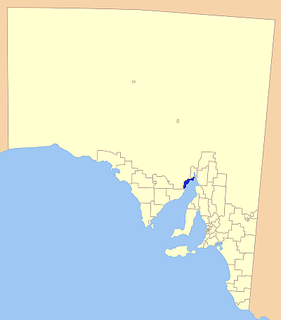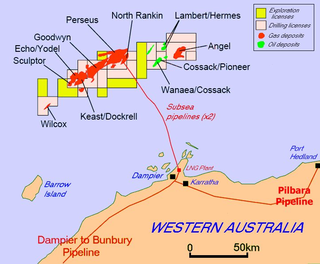Related Research Articles

Whyalla was founded as "Hummocks Hill", and was known by that name until 1916. It is the fourth most populous city in the Australian state of South Australia after Adelaide, Mount Gambier and Gawler. As at June 2018, Whyalla had an urban population of 21,742, having declined at an average annual rate of -0.75% year-on-year over the preceding five years. It is a seaport located on the east coast of the Eyre Peninsula and is known as the "Steel City" due to its integrated steelworks and shipbuilding heritage. The port of Whyalla has been exporting iron ore since 1903.

The Spencer Gulf is the westernmost and larger of two large inlets on the southern coast of Australia, in the state of South Australia, facing the Great Australian Bight. It spans from the Cape Catastrophe and Eyre Peninsula in the west to Cape Spencer and Yorke Peninsula in the east.

Liquefied natural gas (LNG) is natural gas (predominantly methane, CH4, with some mixture of ethane, C2H6) that has been cooled down to liquid form for ease and safety of non-pressurized storage or transport. It takes up about 1/600th the volume of natural gas in the gaseous state (at standard conditions for temperature and pressure).
Santos Ltd. is an Australian energy company, the country's second-largest independent oil and gas producer. In the 2020 Forbes Global 2000, Santos was ranked as the 1583rd -largest public company in the world.

The Eyre Peninsula is a triangular peninsula in South Australia. It is bounded on the east by Spencer Gulf, the west by the Great Australian Bight, and the north by the Gawler Ranges.

Port Giles is a port on Yorke Peninsula in the Australian state of South Australia located in the gazetted locality of Coobowie between the towns of Stansbury and Edithburgh.

Sepia apama, also known as the giant cuttlefish and Australian giant cuttlefish, is the world's largest cuttlefish species, growing to 50 cm (20 in) in mantle length and over 10.5 kg (23 lb) in weight. Using cells known as chromatophores, the cuttlefish can put on spectacular displays, changing color in an instant.
Pengerang is a mukim and a municipal area in Kota Tinggi District, Johor, Malaysia. It is located in the southeastern end of the district.

The City of Whyalla is a local government area in South Australia, located at the north-east corner of the Eyre Peninsula. It was established in 1970, replacing the town commission, which had been running the town previously. The district is mostly industrial, with many large companies having factories in the city.

Port Bonython is the location of a deepwater port, gas fractionation plant and diesel storage facility west of Point Lowly in the Upper Spencer Gulf region of South Australia. It lies 16 km east-northeast of Whyalla, South Australia and approximately 370 km north-west of the State's capital city, Adelaide. The existing wharf is 2.4 kilometres long and is capable of berthing small Capesize ships with a maximum capacity of 110,000 tonnes. The wharf was established in 1982 and named after John Bonython, the founding chairman of Santos Limited. The structure is leased to Santos by the South Australian Government and is used for the export of hydrocarbon products. An oil spill at Port Bonython in 1992 resulted in loss of bird life and damage to mangrove habitats to the west and southwest of Port Pirie.

The North West Shelf Venture, situated in the north-west of Western Australia, is Australia's largest resource development project. It involves the extraction of petroleum at offshore production platforms, onshore processing and export of liquefied natural gas, and production of natural gas for industrial, commercial and domestic use within the state.

Port Kembla is a man-made cargo port or artificial harbour, with an outer harbour protected by breakwaters and an inner harbour constructed by dredging, located in the Illawarra region of New South Wales, Australia.
The Port of Paulsboro is located on the Delaware River and Mantua Creek in and around Paulsboro, in Gloucester County, New Jersey, United States, approximately 78 miles (126 km) from the Atlantic Ocean. Traditionally one of the nation's busiest for marine transfer operations, notably for crude oil and petroleum products, such as jet fuel and asphalt, it is a port of entry with several facilities within a foreign trade zone.

Point Lowly is the tip of a small peninsula north north-east of Whyalla in the Upper Spencer Gulf region of South Australia. The wider peninsula is shared by a combination of defence, industrial, residential, recreational and tourism interests. Port Bonython lies immediately to the north-west and is marked for future industrial expansion, driven by anticipated growth in the State's mining industry. The icons of the peninsula are the historic Point Lowly Lighthouse and the mass breeding aggregation of giant Australian cuttlefish which occurs inshore each winter.
The Port Bonython oil spill occurred on 30 August 1992, when the fuel tank of the tanker Era was pierced by the bow of the tugboat Turmoil during berthing operations in upper Spencer Gulf, South Australia. Wind and swell were high and 296 tonnes of bunker fuel were released into Spencer Gulf. The incident resulted in 500 oiled birds and damage to 15 km of mangrove and seagrass habitat south-west of Port Pirie.
Transport in South Australia is provided by a mix of road, rail, sea and air transport. The capital city of Adelaide is the centre to transport in the state. With its population of 1.4 million people, it has the majority of the state's 1.7 million inhabitants. Adelaide has the state's major airport and sea port.
The Alternative Port Working Party is a community action group based in Whyalla, South Australia on the shore of northern Spencer Gulf. Its membership includes a number of retired engineers with experience in mining, shipping and bulk commodities handling and its chief spokesperson is Sid Wilson. Since its formation, the group has advocated for a 'best of both' scenario for the nearby Point Lowly peninsula; one which represents the interests of both the local economy and residential, recreational and tourist use of the peninsula. They believe that the chosen locations for proposed facilities in the Port Bonython and Point Lowly area present unacceptable compromises, and thus have recommended a number of alternatives.
Save Point Lowly is a community action group based in Whyalla, South Australia. The group was formed circa 2008 to present an alternative vision for the future of the Point Lowly area north-west of Whyalla and resist plans for heavy industrialization. The group aspired to raising the profile of the Point Lowly area, including the giant Australian cuttlefish aggregation, which the group believes is under threat from a number of industrial proposals including: a seawater desalination plant for BHP Billiton's Olympic Dam mine, a diesel distribution hub, a technical ammonium nitrate plant and an iron ore export facility. Collectively these development have been referred to by the Government of South Australia as the Port Bonython Minerals Precinct. The group's spokesperson and chairman is Andrew Melville-Smith who is a practising veterinarian and resident of Whyalla.

North Killingholme Haven is a water outlet on the south bank of the Humber Estuary in the civil parish of North Killingholme, to the north-west of the Port of Immingham.

The Fremantle Outer Harbour is the part of Fremantle Harbour located in the Cockburn Sound, at the City of Kwinana, Western Australia. Fremantle Harbour consists of the Inner Harbour, which is situated on the mouth of the Swan River; and the Outer Harbour, which is 20 km to the south. It is managed by the Fremantle Port Authority.
References
- ↑ "Whyalla & Eyre Peninsula - Regional Plan August 2012" (PDF). Regional Development Australia. 2012-08-01. Archived from the original (PDF) on 2015-07-13. Retrieved 2015-07-13.
- 1 2 "STU - Port Bonython Fuels Development Application Lodged - Mr Tino Guglielmo, Managing Director". BRR. 2009-05-26. Retrieved 2015-07-12.
- ↑ BRUCE, KAYLEIGH. "Fuel terminal on track" . Retrieved 2015-06-30.
- ↑ "Mitsubishi Corporation to launch diesel business in Australia | Australian Manufacturing". www.australianmanufacturing.com.au. Retrieved 2015-07-01.
- 1 2 Mayfield, Louis (2016-05-10). "Supplying the industry 'lifeblood'". Whyalla News. Retrieved 2016-05-11.
- ↑ Petroleum import infrastructure in Australia - Main report (PDF). Melbourne, Australia: ACIL Tasman. 2009. p. 84.
- ↑ "Port Bonython Bulk Commodities Export Facility Overview of Draft Environmental Impact Statement" (PDF). Archived from the original (PDF) on 2015-09-24.
- 1 2 "www.gmusg.com/WSCMConfig/Presentation/Item218.pdf" (PDF). www.gmusg.com. Retrieved 2015-06-30.[ dead link ]
- ↑ "Final Report - Port Bonython Jetty Refurbishment" (PDF). 2010-11-11.
- ↑ "Port Bonython green light signals diesel market shake-up". www.fullyloaded.com.au. Retrieved 2015-07-12.
- ↑ "Mining infrastructure growth". New Connections: 6. 2008-08-01.
- ↑ "Port Bonython Fuels". Port Bonython Fuels. Retrieved 2015-06-30.
- ↑ "$110m diesel facility for Port Bonython - InDaily | Adelaide News" . Retrieved 2015-07-13.
- ↑ BILNEY, KATE. "Diesel terminal for Port Bonython" . Retrieved 2015-06-30.
- ↑ "Environmental fears fuel Port Bonython terminal opposition". ABC News. Retrieved 2015-06-30.